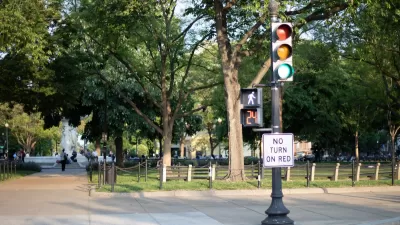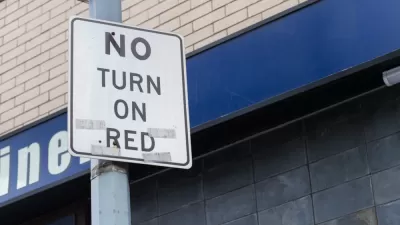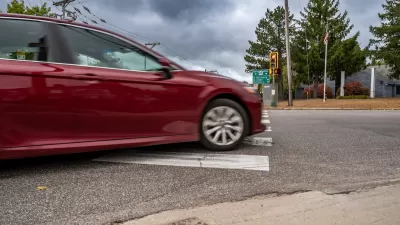The policy, which stems from the gas embargo of the 1970s, makes intersections more dangerous for pedestrians.

In a segment for NPR, Ally Schweitzer highlights a growing movement to ban right turns on red, a 1970s policy that leads to more pedestrian deaths and injuries.
Schweitzer notes Washington, D.C.’s recent decision to prohibit cars from turning right on red lights, adding that San Francisco, Cambridge, Massachusetts, and other cities are doing the same.
According to San Francisco city supervisor Dean Preston, “We saw an 80% decrease in close calls and a 70% decrease in vehicles blocking or encroaching the sidewalks during red lights” after making the change in that city’s Tenderloin district.
Road safety advocates say turning right on red increases the likelihood of car-pedestrian collisions and forces drivers into crosswalks. According to a 2023 Fast Company article, “A 1982 study found that the new policy triggered a sharp increase in crashes involving conflicts between a pedestrian or cyclist and a right-turning vehicle. In Ohio, for instance, such collisions rose 57% for pedestrians and 80% for cyclists; in Wisconsin, the figures were 107% and 72%, respectively.”
If driving through an intersection without stopping may be more fuel-efficient, American cities could consider traffic circles and roundabouts as another option for maintaining traffic flow and reducing congestion.
FULL STORY: More cities are banning right turns on red in response to rising pedestrian deaths

Alabama: Trump Terminates Settlements for Black Communities Harmed By Raw Sewage
Trump deemed the landmark civil rights agreement “illegal DEI and environmental justice policy.”

Planetizen Federal Action Tracker
A weekly monitor of how Trump’s orders and actions are impacting planners and planning in America.

The 120 Year Old Tiny Home Villages That Sheltered San Francisco’s Earthquake Refugees
More than a century ago, San Francisco mobilized to house thousands of residents displaced by the 1906 earthquake. Could their strategy offer a model for the present?

Ken Jennings Launches Transit Web Series
The Jeopardy champ wants you to ride public transit.

BLM To Rescind Public Lands Rule
The change will downgrade conservation, once again putting federal land at risk for mining and other extractive uses.

Indy Neighborhood Group Builds Temporary Multi-Use Path
Community members, aided in part by funding from the city, repurposed a vehicle lane to create a protected bike and pedestrian path for the summer season.
Urban Design for Planners 1: Software Tools
This six-course series explores essential urban design concepts using open source software and equips planners with the tools they need to participate fully in the urban design process.
Planning for Universal Design
Learn the tools for implementing Universal Design in planning regulations.
Clanton & Associates, Inc.
Jessamine County Fiscal Court
Institute for Housing and Urban Development Studies (IHS)
City of Grandview
Harvard GSD Executive Education
Toledo-Lucas County Plan Commissions
Salt Lake City
NYU Wagner Graduate School of Public Service





























